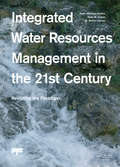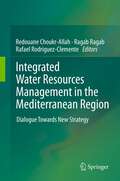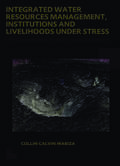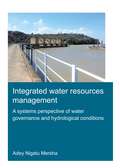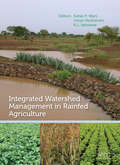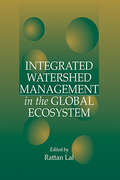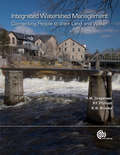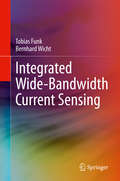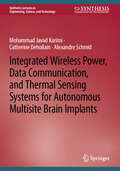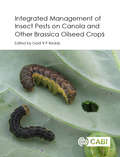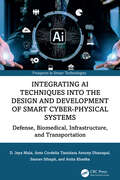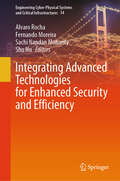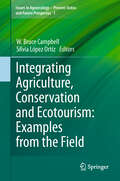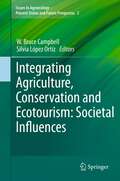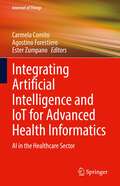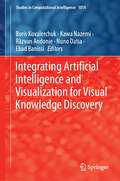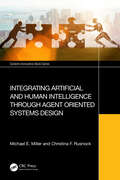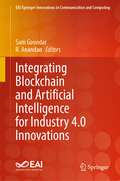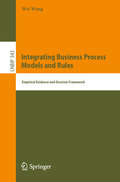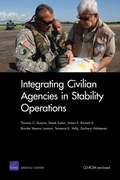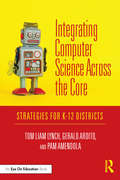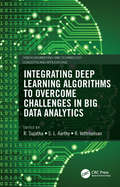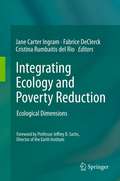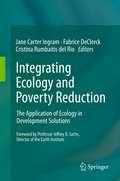- Table View
- List View
Integrated Water Resources Management in the 21st Century: Revisiting the paradigm
by Maite M. Aldaya M. Ramón Llamas Pedro Martinez-SantosIntegrated water resources management (IWRM) advocates a coordinated approach for managing water resources in a way that balances social and economic needs with care for nature. While attractive, IWRM is both controversial and elusive. This book provides a down-to-earth approach to the elusive concept of integrated water resources management, drawing from conceptual frameworks and real-life practice to identify the key aspects that are yet to be resolved, it examines the role of water accounting, food trade, environmental externalities and intangible values as key aspects whose resolution will help the IWRM community move forward.
Integrated Water Resources Management in the Mediterranean Region
by Rafael Rodriguez-Clemente Ragab Ragab Redouane Choukr-AllahThis book puts great emphasis on the importance of Integrated Water Resources Management IWRM as the way forward towards food, water, and energy security. It offers better ways and means of managing the limited water resources; using water more efficiently; adopting new policies in order to cope with climate change and drought; increase water supply through the use of non conventional water resources, especially waste water; inducing stakeholders participation and information exchange and raise public awareness to the value of water. It is an important book for all those involved in all aspects of water resources and contains valuable information for scientists, researchers, farmers, extension services and students.
Integrated Water Resources Management, Institutions and Livelihoods under Stress: Bottom-up Perspectives from Zimbabwe; UNESCO-IHE PhD Thesis (IHE Delft PhD Thesis Series)
by Collin C. MabizaThe majority of people in Limpopo river basin depend on rainfed agriculture. Unfortunately the Limpopo is water scarce, and parts of the basin, such as Zimbabwe's Mzingwane catchment, are under stress in terms of agro-ecological and socio-politicoeconomic conditions. Integrated Water Resources Management (IWRM) has been adopted in the river basin i
Integrated Water Resources Management: Integrated Water Resources Management (IHE Delft PhD Thesis Series)
by Adey NIgatu MershaThis thesis presents analysis of the status of IWRM implementation along with the challenges with regards to policy and institutional measures as well as the required basin information and management instruments. The research entailed a detailed analysis of water resources systems based on a case study from the Awash River Basin in Ethiopia, covering the historical and present state of the challenges and gaps in policies, institutional arrangements and management instruments. The status quo of practical water management, implications of plausible management alternatives in terms of their impact to future water availability, demand fulfilment, patterns of use, and sustainability of the environment were examined. Moreover, the interlinkages and dynamics between key water dependent resources sectors, broadly categorized into water, energy, food, and ecosystems (WEFE) was explored to identify key tradeoffs and synergies. This was deliberated as to improving the synchronization of sectoral plans and resources management programs, thereby fast-tracking the coordination process in IWRM. Overall, the research provides a clearer understanding of the system-wide problems, structural challenges and possible future consequences regarding the management and sustainability of the entire water resource system. Ultimately the purpose is to set in motion new strategies and mechanisms to improve the implementation of the currently applied IWRM framework in the context of the SDGs.
Integrated Watershed Management in Rainfed Agriculture
by Suhas P. Wani Johan Rockstrom Kanwar Lal SahrawatThis book provides a comprehensive presentation of the realization of improved rain fed agriculture yield in semi-arid and dry land areas. Besides techniques to improve the livelihood of small-scale farmers in developing countries, it includes examples and case studies for further support. The methods discussed have shown to be successful and economically remunerative in India and various African countries. Intended for professionals (investors, policy makers), researchers and (post)graduate students working on dry land and sustainable agriculture and water and natural resources management. Suited for courses in dry land agriculture, soil / water management and watershed development.
Integrated Watershed Management in the Global Ecosystem
by Rattan LalFocusing on the technical, social, and economic issues involved in watershed management, this interdisciplinary author team focuses on bettering land use practices and the condition of soil water resources.Integrated Watershed Management in the Global Ecosystem is a volume composed from an international symposium of the world's leading experts
Integrated Watershed Management: Connecting People to Their Land and Water
by Kenneth N. Brooks Hans M. Gregersen Peter F. FolliottGregersen, Folliott, and Brooks provide government agencies and other bodies with background information, factors to be considered, and procedures that facilitate organizing and guiding land and water use in concert with one another. The book can also serve as a reference for planning, monitoring, and implementing development efforts and natural resource management using the integrated watershed management approach. Annotation ©2008 Book News, Inc., Portland, OR (booknews.com)
Integrated Wide-Bandwidth Current Sensing
by Tobias Funk Bernhard WichtThis book provides readers with a single-source reference to current sensing integrated circuit design. It is written in handbook style, including systematic guidelines and implementation examples. The authors focus on the implementation of wide-bandwidth current sensing on a single microchip, toward usage in applications such as sensing, control and optimization of the energy flow in growth areas like industrial electronics, renewable energies, smart grids, electromobility and the Internet of Things.Provides readers with a comprehensive, all-in-one source for current sensing integrated circuit design, including implementation examples;Discusses modeling and optimization of on-chip Rogowski coil and Hall sensor in both lateral and vertical orientation;Includes noise reduction techniques, such as auto-zeroing and chopping;Covers open-loop and closed-loop sensor front-end design;Presents the first on-chip current sensor with a planar coil placed besides a power line to measure internal signal currents and the first off-chip current sensor with a helix-shaped coil for external signal currents in the multi-MHz region.
Integrated Wireless Power, Data Communication, and Thermal Sensing Systems for Autonomous Multisite Brain Implants (Synthesis Lectures on Engineering, Science, and Technology)
by Alexandre Schmid Catherine Dehollain Mohammad Javad KarimiThis book provides professionals in microelectronic implantable bio-medical systems an overview of recent techniques in wireless power and data telemetry. State-of-the-art techniques are overviewed and original methods presented. The book features an up-to-date overview of CMOS wireless telemetry microelectronics for cortical implants. The book gathers all layers of microelectronics wireless power and data transmission for cortical implants, discusses them in a critical manner and proposes solutions, i.e., at circuit and systems and system levels. This book compiles relevant information into a coherent presentation of the technical issues, proposed solutions and their compared efficiency, and details the authors&’ original approaches. Professionals of microelectronics will find useful and accessible descriptions of the major issues and solutions to wireless telemetry. Researchers and professionals in bio-medical implantable systems will find fully justified novel methods in power and data telemetry and implantable systems telemetry architectures.
Integrated management of Insect Pests on Canola and other Brassica Oilseed Crops
by Tao Li Peter Mason Kevin D Floate John Gavloski Hector Cárcamo Matthew P. Hill Harit K Bal Ronald E Batallas Tulsi Bhardwaj James D Blande Dhana Raj Boina G David Buntin Randall Brandt Surendra Dara Tim J Dumonceaux Robert H Elliott Maya Evenden Yaghoub Fathipour Kristopher L Giles Larry Grenkow Parwinder Grewal Rebecca H Hallett Vincent A Hervet Sari J. Himanen Heikki M.T. Hokkanen Jarmo K Holopainen Prashant Jha Janet J Knodel Sarina Macfadyen Ingeborg Menzler-Hokkanen Mohammad Ali Mirhosseini Christine Noronha Chrystel Olivier Francisco Rubén Badenes-Pérez S. Jesu Rajan Tom Royer Muhammad Sarwar Barbara Sharanowski Govinda Shrestha Juliana Soroka Rajagopalbabu Srinivasan Raj Kumar Thakur Sally Vail Leyun Wang R W Wanigasekara Chaminda De Weeraddana Tyler J Wist Zi-Hua ZhaoThis book comprehensively reviews current pest management practices and explores novel integrated pest management strategies in Brassica oilseed crops. It is essential reading for pest management practitioners and researchers working on pest management in canola and other Brassica crops worldwide. Canola, mustard, camelina and crambe are the most important oilseed crops in the world. Canola is the second largest oilseed crop in the world providing 13% of the world's supply. Seeds of these species commonly contain 40% or more oil and produce meals with 35 to 40% protein. However, its production has declined significantly in recent years due to insect pest problems. The canola pest complexes are responsible for high insecticide applications on canola. Many growers rely on calendar-based spraying schedules for insecticide applications. The diamondback moth Plutella xylostella and flea beetles Phyllotreta spp. (P. cruciferae and P. striolata)cause serious damage to canola. In the Northern Great Plains, USA, for instance, P. xylostella is now recorded everywhere that canola is grown. Severe damage to canola plants can be caused by overwintering populations of flea beetles feeding on newly emerged seedlings. Cabbage seed pod weevil (Ceutorhynchus obstrictus), swede midge (Contarinia nasturtii), and tarnished plant bug (Lygus lineolaris) are also severe pests on canola. Minor pests include aphids (cabbage aphid, Brevicoryne brassicae and turnip aphid, Hyadaphis erysimi) and grasshopper, Melanoplus sanguinipes. This book: · is the only single compiled source of information on integrated management of canola and other Brassica oilseed pests · presents the biology and management of all the major and minor pests of Brassica oilseed crops · is an essential source of information for applied entomologists, crop protection researchers, extension agents and stakeholders
Integrating AI Techniques into the Design and Development of Smart Cyber-Physical Systems: Defense, Biomedical, Infrastructure, and Transportation (Prospects in Smart Technologies)
by D. Jeya Mala Anto Cordelia Dhanapal Saurav Sthapit Anita KhadkaBuilding on the knowledge of risks, vulnerabilities, and safety measures associated with cyber-physical systems, this book focuses on adapting artificial intelligence (AI) techniques to smart cyber-physical systems application development. The future is going to see cyber-physical systems in almost every aspect of life, so a book that focuses on shedding light on the design, development, and security aspects of cyber-physical systems in more crucial domains such as defense, healthcare, biomedical, smart city applications, is needed.Integrating AI Techniques into the Design and Development of Smart Cyber-Physical Systems: Defense, Biomedical, Infrastructure, and Transportation offers an introductory exploration of the fundamental theories and concepts of AI and machine learning (ML) that are utilized in the building of dependable cyber-physical systems. It brings the ideas of advanced design and development and empowered security measures to cyber-physical systems. By focusing on the application of AI in cyber-physical systems design as well as security aspects, an improvement in reliability and advancements can be explored. Also included are the latest findings and advancements as well as case studies and illustrative examples on the design and development of smart cyber-physical systems.This resource is highly valuable for those employed in educational institutions, research laboratories, enterprises, and government agencies, as well as for students seeking novel ideas in the realm of smart cyber-physical systems design.
Integrating Advanced Technologies for Enhanced Security and Efficiency (Engineering Cyber-Physical Systems and Critical Infrastructures #14)
by Alvaro Rocha Shu Hu Sachi Nandan Mohanty Fernando MoreiraThis book examines the profound impact of emerging innovations on security and operational effectiveness. This book brings together leading experts in artificial intelligence, blockchain, IoT, and cyber security to tackle key challenges in protecting digital and physical infrastructures. Covering areas such as automated threat detection, secure data exchange, and intelligent system optimization, the book offers practical strategies and case studies. Designed for researchers, professionals, and policymakers, it serves as a comprehensive resource for harnessing advanced technologies to build resilient and efficient security frameworks. Whether mitigating cyber threats, streamlining industrial operations, or improving decision-making, this book provides essential insights for navigating today&’s rapidly evolving technological landscape.
Integrating Agriculture, Conservation and Ecotourism: Examples from the Field
by W. Bruce Campbell Silvia López OrtízIssues In Agroecology - Present Status and Future Prospectus not only reviews aspects of ecology, but the ecology of sustainable food production systems, and related societal and cultural values. To provide effective communication regarding status and advances in this field, this series connects with many disciplines such as sociology, anthropology, environmental sciences, ethics, agriculture, economics, ecology, rural development, sustainability, policy and education, and integrations of these general themes so as to provide integrated points of view that will help lead to a more sustainable construction of values than conventional economics alone. Such designs are inherently complex and dynamic, and go beyond the individual farm to include landscapes, communities, and biogeographic regions by emphasizing their unique agricultural and ecological values, and their biological, societal, and cultural components and processes.
Integrating Agriculture, Conservation and Ecotourism: Societal Influences
by W. Bruce Campbell Silvia López OrtízAgroecology not only encompasses aspects of ecology, but the ecology of sustainable food production systems, and related societal and cultural values. To provide effective communication regarding status and advances in this field, connections must be established with many disciplines such as sociology, anthropology, environmental sciences, ethics, agriculture, economics, ecology, rural development, sustainability, policy and education, or integrations of these general themes so as to provide integrated points of view that will help lead to a more sustainable construction of values than conventional economics alone. Such designs are inherently complex and dynamic, and go beyond the individual farm to include landscapes, communities, and biogeographic regions by emphasizing their unique agricultural and ecological values, and their biological, societal, and cultural components and processes.
Integrating Artificial Intelligence and IoT for Advanced Health Informatics: AI in the Healthcare Sector (Internet of Things)
by Carmela Comito Agostino Forestiero Ester ZumpanoThe book covers the integration of Internet of Things (IoT) and Artificial Intelligence (AI) to tackle applications in smart healthcare. The authors discuss efficient means to collect, monitor, control, optimize, model, and predict healthcare data using AI and IoT. The book presents the many advantages and improvements in the smart healthcare field, in which ubiquitous computing and traditional computational methods alone are often inadequate. AI techniques are presented that play a crucial role in dealing with large amounts of heterogeneous, multi-scale and multi-modal data coming from IoT infrastructures. The book is intended to cover how the fusion of IoT and AI allows the design of models, methodologies, algorithms, evaluation benchmarks, and tools can address challenging problems related to health informatics, healthcare, and wellbeing.
Integrating Artificial Intelligence and Visualization for Visual Knowledge Discovery (Studies in Computational Intelligence #1014)
by Ebad Banissi Kawa Nazemi Boris Kovalerchuk Răzvan Andonie Nuno DatiaThis book is devoted to the emerging field of integrated visual knowledge discovery that combines advances in artificial intelligence/machine learning and visualization/visual analytic. A long-standing challenge of artificial intelligence (AI) and machine learning (ML) is explaining models to humans, especially for live-critical applications like health care. A model explanation is fundamentally human activity, not only an algorithmic one. As current deep learning studies demonstrate, it makes the paradigm based on the visual methods critically important to address this challenge. In general, visual approaches are critical for discovering explainable high-dimensional patterns in all types in high-dimensional data offering "n-D glasses," where preserving high-dimensional data properties and relations in visualizations is a major challenge. The current progress opens a fantastic opportunity in this domain. This book is a collection of 25 extended works of over 70 scholars presented at AI and visual analytics related symposia at the recent International Information Visualization Conferences with the goal of moving this integration to the next level. The sections of this book cover integrated systems, supervised learning, unsupervised learning, optimization, and evaluation of visualizations. The intended audience for this collection includes those developing and using emerging AI/machine learning and visualization methods. Scientists, practitioners, and students can find multiple examples of the current integration of AI/machine learning and visualization for visual knowledge discovery. The book provides a vision of future directions in this domain. New researchers will find here an inspiration to join the profession and to be involved for further development. Instructors in AI/ML and visualization classes can use it as a supplementary source in their undergraduate and graduate classes.
Integrating Artificial and Human Intelligence through Agent Oriented Systems Design (Systems Innovation Book Series)
by Michael E. Miller Christina F. RusnockThis book departs from the assumption that Artificial Intelligence (AI) systems will provide a maximum advantage by replacing human cognitive processing. Instead, this book subscribes to the assumption that AI systems will provide a maximal advantage when the system is specifically designed to augment human intelligence. It provides methods for designing effective systems that include one or more humans and one or more AI entities and uses the approach that assumes automation does not replace human activity but fundamentally changes the structure of human work when AI is added to existing systems.Integrating Artificial and Human Intelligence through Agent Oriented Systems Design discusses the potential impact of AI on human work and life and explores why teamwork is necessary today for complex work environments. The book explains the processes and methods humans employ to effectively team with one another and presents the elements of artificial agents that permit them to function as team members in joint human and artificial teams. It discusses design goals and illustrates how the methods that have been used to model the complex interactions among human and artificial agents can be expanded to enable the design of interaction between them to make possible the attainment of the shared goals. Model-Based Systems Engineering (MBSE) tools that provide logical designs of human–agent teams, the AI within these teams, training to be deployed for human and artificial agent team members, and the interfaces between human and artificial agent team members are all covered. MBSE files containing profiles and examples for building MBSE models used in the design approach are featured on the author’s website (https://lodesterresci.com/hat).This book is an ideal read for students, professors, engineers, and project managers associated with designing and developing AI systems or systems that seek to incorporate AI.
Integrating Big Data and IoT for Enhanced Decision-Making Systems in Business: Volume 1 (Studies in Big Data #177)
by Reem Khamis HamdanThis book presents recent research on integrating big data and IoT for enhanced decision-making systems in business. Unlock the future of smart decision-making! This volume dives technology innovation, and human capital growth, empowering leaders, educators, and entrepreneurs to transform businesses, education, and economies for a sustainable digital era.
Integrating Blockchain and Artificial Intelligence for Industry 4.0 Innovations (EAI/Springer Innovations in Communication and Computing)
by Sam Goundar R. AnandanThis book discusses the convergence of artificial intelligence (AI) and Blockchain and how they can work together to help reach the goals of Industry 4.0. The authors first discuss how AI and Blockchain can help increase performance in business. The authors go on to discuss how the technologies can integrate to provide a competitive edge for businesses through improvements in big data, which has allowed firms to organize huge datasets into structured components that computers can process quickly. The authors also cover security implications and how AI and Blockchain can act as a double-edged sword against cyber-attacks. Impacts in programming, calculations, robotization, robots, and equipment are also discussed. This book caters to an extensive cross-sectional and multi-disciplinary readership. Academics, researchers and their students in topics such as artificial intelligence, cyber-physical systems, ethics, robotics, safety engineering, and safety-critical systems should find the book of value.
Integrating Business Process Models and Rules: Empirical Evidence And Decision Framework (Lecture Notes in Business Information Processing #343)
by Wei WangThis book combines multiple research methods, experiment, survey, and design science, as well as traditional measurements and neurophysiological techniques that can capture a variety of cognitive behaviors in human information processing, providing more solid and comprehended research findings. While the focus of the book is the modelling of process models and rules, the methods and techniques used in this book can also be adopted and applied to broader conceptual modelling research incorporating a variety of notations (e.g. UML, ER diagrams) or ontologies.It is a revised version of the PhD dissertation written by the author at the School of Information Technology and Electrical Engineering of the University of Queensland, Australia. In 2018, the PhD dissertation won the "CAiSE PhD Award," granted to outstanding PhD theses in the field of information systems engineering.
Integrating Civilian Agencies in Stability Operations
by Terrence K. Kelly Derek Eaton Brooke Stearns Lawson Thomas S. Szayna James E. BarnettHow can the Army help make key civilian agencies more capable partners in stability, security, transition, and reconstruction (SSTR) operations? The authors identify the civilian agencies that should be involved in such operations, then locate the necessary skill sets. They then assess the capacity of the civilian agencies to participate in SSTR operations and analyze the recurring structural problems that have plagued their attempts to do so.
Integrating Computer Science Across the Core: Strategies for K-12 Districts
by Tom Liam Lynch Gerald Ardito Pam AmendolaIntegrating Computer Science Across the Core is a guide to systematizing computer science and computational thinking practices in your school. While most books explain how to teach computer science as a stand-alone discipline, this innovative approach will help you leverage your existing curriculum to deepen and expand students’ learning experiences in all content areas. Effective, equitable, and sustainable, this blueprint provides principals, curriculum directors, directors of technology, and other members of your school or district leadership team with suggested organizational structures, tips for professional learning, and key resources like planning instruments.
Integrating Deep Learning Algorithms to Overcome Challenges in Big Data Analytics (Green Engineering and Technology)
by R. SujathaData science revolves around two giants: Big Data analytics and Deep Learning. It is becoming challenging to handle and retrieve useful information due to how fast data is expanding. This book presents the technologies and tools to simplify and streamline the formation of Big Data as well as Deep Learning systems. This book discusses how Big Data and Deep Learning hold the potential to significantly increase data understanding and decision-making. It also covers numerous applications in healthcare, education, communication, media, and entertainment. Integrating Deep Learning Algorithms to Overcome Challenges in Big Data Analytics offers innovative platforms for integrating Big Data and Deep Learning and presents issues related to adequate data storage, semantic indexing, data tagging, and fast information retrieval. FEATURES Provides insight into the skill set that leverages one’s strength to act as a good data analyst Discusses how Big Data and Deep Learning hold the potential to significantly increase data understanding and help in decision-making Covers numerous potential applications in healthcare, education, communication, media, and entertainment Offers innovative platforms for integrating Big Data and Deep Learning Presents issues related to adequate data storage, semantic indexing, data tagging, and fast information retrieval from Big Data This book is aimed at industry professionals, academics, research scholars, system modelers, and simulation experts.
Integrating Ecology and Poverty Reduction: Ecological Dimensions
by Cristina Rumbaitis del Rio Fabrice Declerck Jane Carter IngramIn the past, the science of ecology has frequently been excluded from the development agenda for various reasons. Increasingly however there has been a renewed interest in finding more ecologically sustainable means of development that have required a strong foundation in ecological knowledge (for example EcoAgriculture Partnerships, EcoHealth presented at ESA, and EcoNutrition proposed by Deckelbaum et al). Each of these examples has already taken the critical first step at integrating ecological knowledge with agriculture, health and nutrition, respectively. However, this is only the first step; more attention needs to be placed not only on the role that two fields can play towards poverty alleviation, but on the role of a truly integrated, interdisciplinary approach towards development goals that is firmly grounded in ecological understanding. We feel that a critical look at what ecology can and cannot provide to the development agenda, in light of the Millennium Development goals, is timely and crucial. The introduction and the final section of the book will then integrate the lessons and principles outlined in each of the chapters. All chapter authors will be heavily encouraged to focus on how their sub-discipline in ecology impacts overall human well-being and environmental sustainability.
Integrating Ecology and Poverty Reduction: The Application of Ecology in Development Solutions
by Cristina Rumbaitis del Rio Fabrice Declerck Jane Carter IngramIn the past, the science of ecology has frequently been excluded from the development agenda for various reasons. Increasingly however there has been a renewed interest in finding more ecologically sustainable means of development that have required a strong foundation in ecological knowledge (for example EcoAgriculture Partnerships, EcoHealth presented at ESA, and EcoNutrition proposed by Deckelbaum et al). Each of these examples has already taken the critical first step at integrating ecological knowledge with agriculture, health and nutrition, respectively. However, this is only the first step; more attention needs to be placed not only on the role that two fields can play towards poverty alleviation, but on the role of a truly integrated, interdisciplinary approach towards development goals that is firmly grounded in ecological understanding. We feel that a critical look at what ecology can and cannot provide to the development agenda, in light of the Millennium Development goals, is timely and crucial. The introduction and the final section of the book will then integrate the lessons and principles outlined in each of the chapters. All chapter authors will be heavily encouraged to focus on how their sub-discipline in ecology impacts overall human well-being and environmental sustainability.
